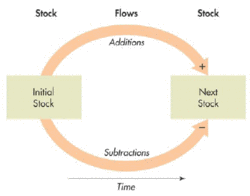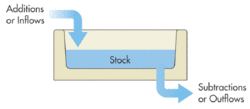Resource maintenance in economies
| Topics: |
Contents
Stocks versus Flows

When noneconomists use the term “stock,” they often mean ownership shares in enterprises that are traded on the “stock market.” To an economist, however, the concept of a stock refers to something as it is measured at a particular point in time. For example, the amount of water in a bathtub can be measured at one particular instant, and that quantity would be considered a stock. The number of computers in an office at 10 o’clock Tuesday morning is a stock, as is the number of trees in a forest at 2 o’clock Saturday afternoon.
On the other hand, flows are measured over a period of time. For example, the water (Water resources) that goes into a bathtub from a faucet is a flow; its quantity can be measured per minute or per hour. The number of computers purchased by an office over the course of this week or this month is a flow. So is the number of computers sold or junked over a period of time. As trees grow or are cut down or felled by lightening, these flows add to or subtract from forest resources.

Flows are like a movie; stocks are like a still photograph. Flows can either add to stocks or decrease them. Figure 1 is a generalized stock-flow diagram, which shows how flows change the level of a stock over time, by either adding to it or taking away from it. For example, the balance in your checking account on January 1 is a stock value. The deposits and withdrawals you make to your checking account are flows; your bank statement will tell you what the various flows were during a month.
Figure 2 gives an alternative representation of the relation of stocks and flows, this time showing a stock at only one point in time. Like water running through the tap (additions) and the drain (subtractions) of a bathtub, flows raise or lower the level of the water in the tub (stock).
Investment and Depreciation
Investment is a primary form of the activity of resource maintenance. When you read the word “investment”, the image in your mind should be of someone buying new computers for an office or planting new trees in a forest—not of someone playing the stock market or “investing in” corporate bonds. Those sort of financial transactions usually merely shift the ownership of an existing financial asset from one economic actor to another; they don’t add to productivity-enhancing capital stocks for the economy at large.
“Disinvestment,” or the running down of capital stocks, can also occur, due to the forces of nature or human activities. When a capital stock is reduced, we say it has undergone depreciation. Natural capital depreciates when rivers become fouled by pollution or more trees are cut down than are naturally regenerated. Manufactured assets commonly lose their usefulness over time, as computers become obsolete, roads develop potholes, and equipment breaks. Human capital depreciates if skills are forgotten or age or illness renders a person less productive, and social capital can depreciate if norms of trust and peaceable interaction become less widely held.
If we measure gross investment, we include all flows into the capital stock over a period of time. Net investment, on the other hand, adjusts this measure for the fact that some portion of the capital stock also depreciates over the same period. The capital stock at the end of the period is equal to the capital stock at the beginning of the period plus only net investment. If depreciation is rapid, net investment can be negative—if the flow of replenishment is not sufficient to keep up with depreciation, the level of the stock will fall.
Resource maintenance activities help to keep up the quantity and quality of important capital stocks. They include such activities as monitoring the water quality of a lake, repairing machinery, or encouraging people to refresh their knowledge. Sometimes resource maintenance “activity” means not engaging in activity. For example, people who make voluntary decisions to minimize their unnecessary gasoline consumption are helping to maintain petroleum resources. While this may look like inactivity, including resource maintenance as an economic activity implies that minimizing some kinds of consumption (Consumption and well-being) can contribute to well-being.
Renewable Resources, Nonrenewable Resources, and Sustainability
In recent years, questions concerning the rate of depreciation of many forms of natural capital have come to the fore. Types of natural capital can be classified as either renewable or non renewable. A renewable resource regenerates itself through biological or other short-term processes, which may be helped out by human activity. The quantity and quality of its stock depend simultaneously on the rate at which the stock maintains its productivity and grows, and on the rate at which it is harvested or polluted. A healthy forest will go on indefinitely producing trees that may be harvested, yielding a flow of lumber that will be used up in production processes such as paper making.
Other kinds of natural capital are nonrenewable resources. Their supply is fixed, although new discoveries can increase the stock that is known to be available. For example, there is a finite amount of fossil fuel reserves, and a finite amount of each kind of mineral, available on the earth. For nonrenewable resources, there are no self-regenerating flows, and the stock can only diminish over time as a result of human use and/or natural deterioration.
How much of its stock of natural resources a society chooses to turn into inputs into current production processes, rather than to preserve for the future, is clearly a very important economic question. Even those natural inputs that are renewable—such as lumber from forests and fish from the seas—may be extinguished if so much of them is destroyed or extracted that they can no longer renew themselves. In addition, there are limits to the ability of nature to absorb polluting by-products of production processes. There are tipping points past which degraded natural capital may dramatically alter in some essential respect.
For example, in the case of climate change (Causes of climate change), rising global temperature due to human-made emissions from the burning of fossil fuels and the use of other chemicals may bring dramatic changes within this century. Ocean levels could rise by up to a meter, or even more because of melting of the Antarctic ice cap and other factors. This could cause the flooding of many low-lying areas, including New Orleans, south Florida, and Bangladesh. Some island nations are already losing significant land mass. Resource maintenance for natural capital means tracking the size, quality, and changes in natural resources and making wise decisions about their management.
Sometimes, when it is pointed out that processes of production and consumption in the industrialized nations are currently depleting many important natural capital stocks much more rapidly than they can be replenished, the issue of substitutability is raised. That is, the depletion of any one resource (such as fossil fuels) is a less serious problem for future well-being, if other resources (such as nuclear or solar energy) can be cheaply and safely substituted in production and consumption. The extent of substitutability depends both on the characteristics of the resources,the speed of technological advance, the policy support, and the strength of institutions. For instance, the Supreme Court of India, was largely responsible for shift in the use of petrol/diesel to Compressed Natural Gas in all public transport vehicles in New Delhi, which has substantially reduced air pollution. Thus, since adoption of new technologies in resource use / extraction has transaction costs on the part of users, and due to political economy, judicial activism is helping in strengthening institutions. However, there are examples otherwise too.
During the late 19th century and the first half of the 20th century, there was a widely felt confidence that human beings could not create any problems to which we could not find adequate and timely solutions. In the late 20th century, however, this faith began to fade in light of increasing ecological damage. Ecologists emphasize the complexity of natural systems and our relative ignorance about long-term, irreversible, or potentially catastrophic effects of economic behavior on the natural systems that support us. They suggest that, instead of placing blind faith in technological progress and economic substitutability, society should adopt a precautionary principle. This principle says that we should err on the cautious side, preferring to cooperate with natural systems rather than assuming we can safely replace them. Or, as stated by one group of experts, "When an activity raises threats of harm to the environment or human health, precautionary measures should be taken even if some cause and effect relationships are not fully established scientifically."
A sustainable (Sustainomics and sustainable development) socioeconomic system creates a flow of whatever is needed (in an economic system, this is goods and services) by using its renewable capital stocks without depleting them. Although some portion of some (especially nonrenewable) capital stocks may be used up in the process of production, the overall quality and quantity of the resource base for sustaining life and well-being are preserved.
Further Reading
- Global Development And Environment Institute, Tufts University
| Disclaimer: This article is taken wholly from, or contains information that was originally published by, the Global Development And Environment Institute. Topic editors and authors for the Encyclopedia of Earth may have edited its content or added new information. The use of information from the Global Development And Environment Institute should not be construed as support for or endorsement by that organization for any new information added by EoE personnel, or for any editing of the original content. |